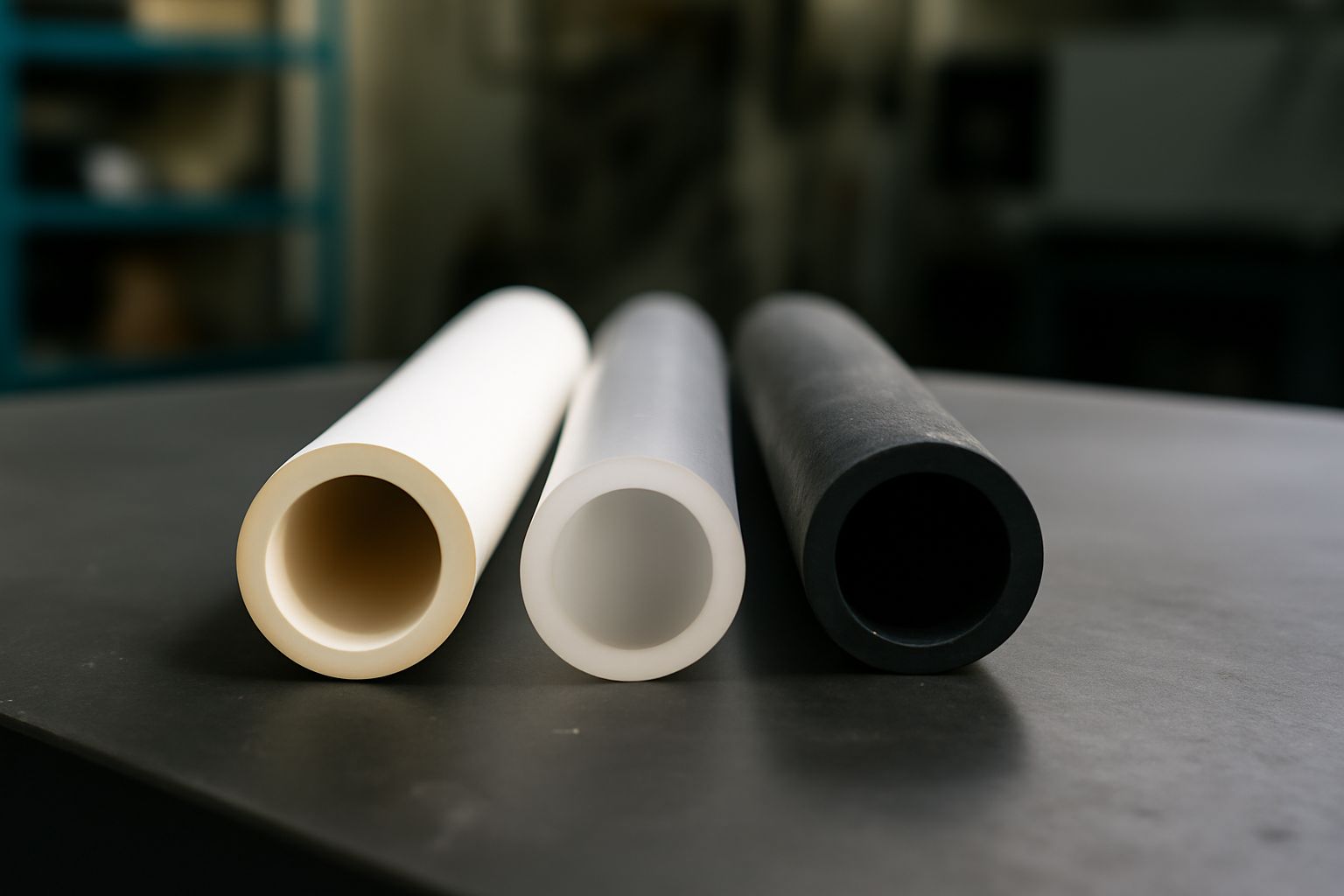Los tubos de alúmina, cuarzo y SiC difieren en temperatura máxima, resistencia y estabilidad química, lo que hace que la selección cuidadosa sea fundamental para hornos, reactores y sistemas de fluidos de precisión.

¿Qué propiedades críticas definen el mejor tubo para uso a alta temperatura?
Estabilidad térmica y resistencia mecánica Son los factores más decisivos para el rendimiento de los tubos a temperaturas elevadas. Los tubos de cerámica de alúmina ofrecen una resistencia excepcional hasta 1700 °C, superando al cuarzo tanto en resistencia como en choque térmico. Tubos de carburo de silicio (SiC) Soportan temperaturas máximas ligeramente más altas y presentan una excelente conductividad térmica, lo que los hace adecuados para entornos de calefacción especializados. El cuarzo, ampliamente utilizado por su pureza y propiedades ópticas, presenta limitaciones debido a su sensibilidad al choque térmico y su menor resistencia.
En mis proyectos de ingeniería, los tubos de alúmina proporcionaron constantemente un rendimiento robusto durante ciclos de calentamiento rápido, mientras que el SiC se seleccionó principalmente para hornos industriales agresivos donde tanto el flujo de calor como la durabilidad eran primordiales.
| Propiedad | Tubo de alúmina | Tubo de cuarzo | Tubo de SiC |
|---|---|---|---|
| Temperatura máxima de trabajo (°C) | 1650-1700 | ~1100 | 1550-1700 |
| Resistencia al choque térmico | Alto | Bajo | Muy alto |
| Resistencia a la flexión (MPa) | >350 | ~65 | >300 |
¿Cómo varía la resistencia química entre los tubos de alúmina, cuarzo y SiC?
Inercia química La alúmina es significativamente diferente: resiste la mayoría de los ácidos y álcalis, excepto los álcalis fuertes a alta temperatura. El cuarzo es muy resistente a la mayoría de los ácidos (excepto el HF), pero reacciona con los álcalis. El carburo de silicio (SiC) muestra una gran resistencia a gases corrosivos, ácidos y metales fundidos, pero puede oxidarse en condiciones extremas. En aplicaciones prácticas, he utilizado tubos de alúmina para procesos con pH ácido y neutro, y SiC donde es probable un ataque agresivo por gases o vapores metálicos. El cuarzo se elige solo cuando la alta pureza y la transparencia también son esenciales.
La elección correcta depende de la combinación exacta de productos químicos y temperatura. Por ejemplo, un fabricante de hornos con sede en EE. UU. informó* que cambió a tubos de SiC, lo que resultó en un intervalo de servicio un 40 % más largo al manipular atmósferas con cloro, en comparación con los tubos de cuarzo anteriores.
| Resistencia química | Alúmina | Cuarzo | Sic |
|---|---|---|---|
| Ácidos fuertes | Excelente | Excelente | Excelente |
| Álcalis fuertes | Limitado (a alta temperatura). | Pobre | Bien |
| Ácido fluorhídrico (HF) | Bien | Muy pobre | Excelente |
| Metales fundidos | Justo | Pobre | Excelente |
*Caso adaptado de: Calefacción industrial
¿Cuáles son las aplicaciones típicas de cada material en entornos industriales?
Selección de materiales El uso de tubos depende del proceso: la alúmina se usa ampliamente en tubos de hornos, analizadores de gases y aislantes de alta tensión debido a su durabilidad y propiedades aislantes. El cuarzo se aplica en procesos de semiconductores y cristalería de laboratorio, donde la pureza y la transparencia térmica son fundamentales. El carburo de silicio se prefiere en hornos industriales y en el transporte de productos químicos corrosivos, gracias a su resistencia a los ciclos térmicos y a las atmósferas agresivas.
Según mi experiencia apoyando a fabricantes de equipos originales (OEM) de hornos europeos, muchos cambiaron de cuarzo a alúmina tras repetidos fallos por agrietamiento. De igual manera, los reactores químicos avanzados utilizan cada vez más tubos de SiC para prolongar la vida útil del sistema y reducir los intervalos de limpieza.
| Solicitud | Tubo de alúmina | Tubo de cuarzo | Tubo de SiC |
|---|---|---|---|
| Tubos de horno | Sí (hasta 1700°C) | Limitado (a ~1100°C) | Sí (hasta 1700°C) |
| Uso en laboratorio | Sí | Sí (especialmente pureza/óptica) | A veces |
| Analizadores de gases / sensores | Sí | Sí | Sí |
| Procesamiento químico/Horno | Sí | A veces | Sí (Preferible) |
¿Pueden los tubos de alúmina reemplazar a los tubos de cuarzo y SiC sin comprometer el rendimiento?
Los tubos de cerámica de alúmina a menudo pueden reemplazar a los tubos de cuarzo y SiC. En entornos de corrosión no extrema y de alta temperatura, ofrece una resistencia superior, buen aislamiento térmico y una mayor compatibilidad química. Sin embargo, para aplicaciones que requieren claridad óptica (p. ej., procesos UV con cuarzo fundido ) o una conductividad térmica ultra alta (como con SiC), las sustituciones pueden no satisfacer todos los requisitos.
Sustituimos regularmente la alúmina por cuarzo en la instrumentación analítica, lo que prolonga la vida útil de los tubos y reduce la frecuencia de mantenimiento. Sin embargo, en condiciones de ciclos de temperatura rápidos y atmósferas extremas, el SiC sigue siendo irreemplazable gracias a su superior resistencia al choque térmico y a la corrosión.
| Escenario de reemplazo | Resultado |
|---|---|
| La alúmina reemplaza al cuarzo en los hornos de laboratorio | Mayor resistencia y vida útil |
| La alúmina reemplaza al SiC en el procesamiento de ácidos suaves | Menor costo, resistencia adecuada |
| Alúmina utilizada en lugar de cuarzo en dispositivos analíticos | Mejor durabilidad mecánica |
| Se requiere SiC para hornos de ciclo rápido | Alúmina insuficiente: utilizar SiC |
T En resumen, los tubos de alúmina ofrecen una combinación única de estabilidad térmica, resistencia y resistencia química, lo que los convierte en un reemplazo ideal para el cuarzo y el SiC en muchas aplicaciones de alta demanda (pero no todas).




 info@csceramic.com
info@csceramic.com







 +86 18273288522
+86 18273288522